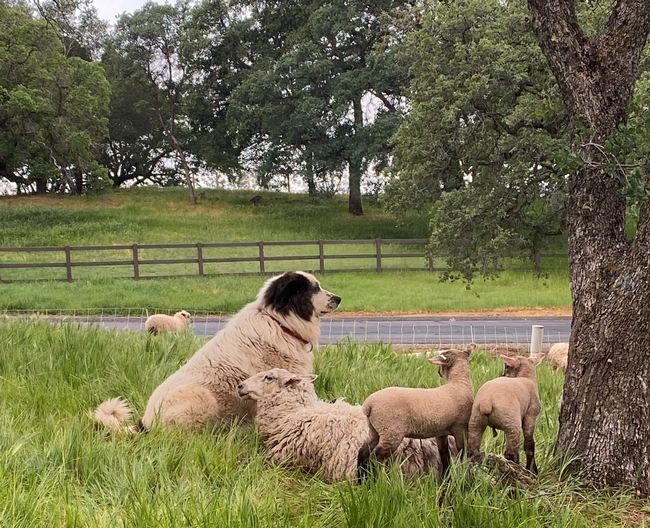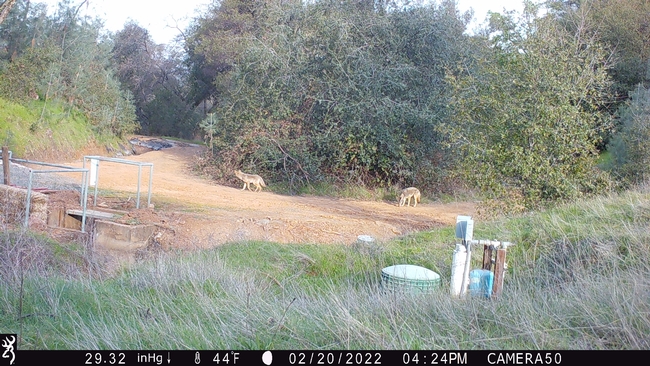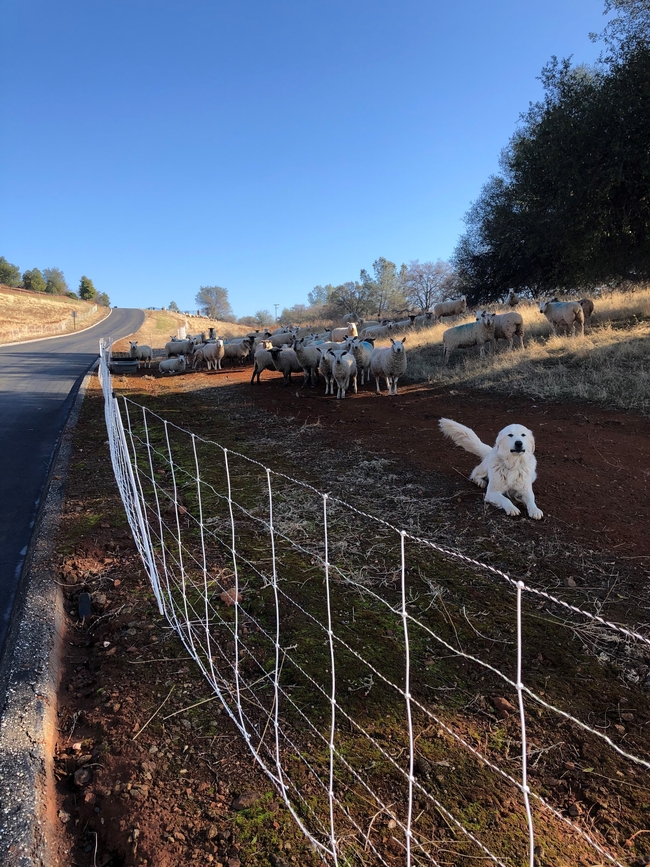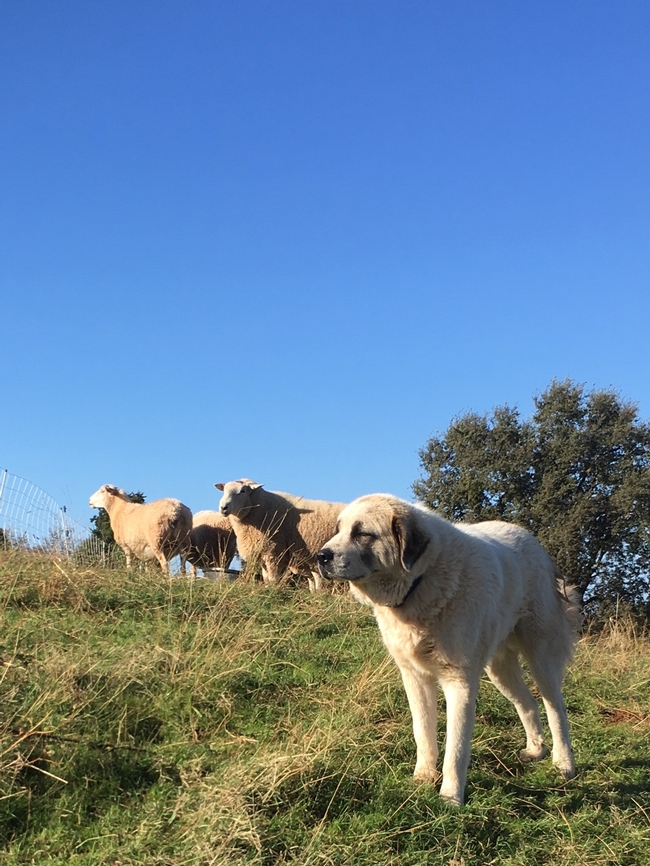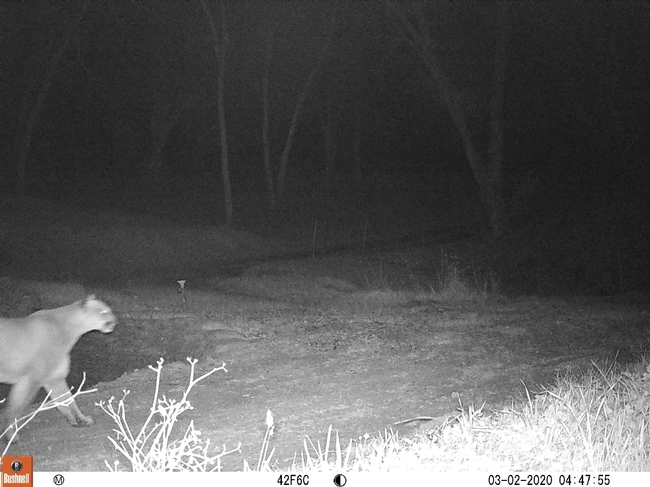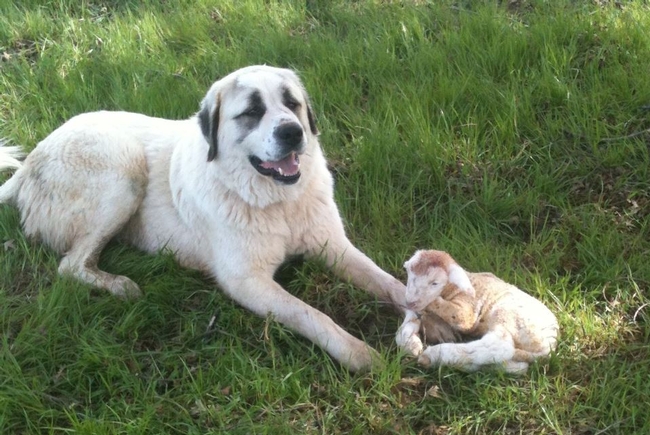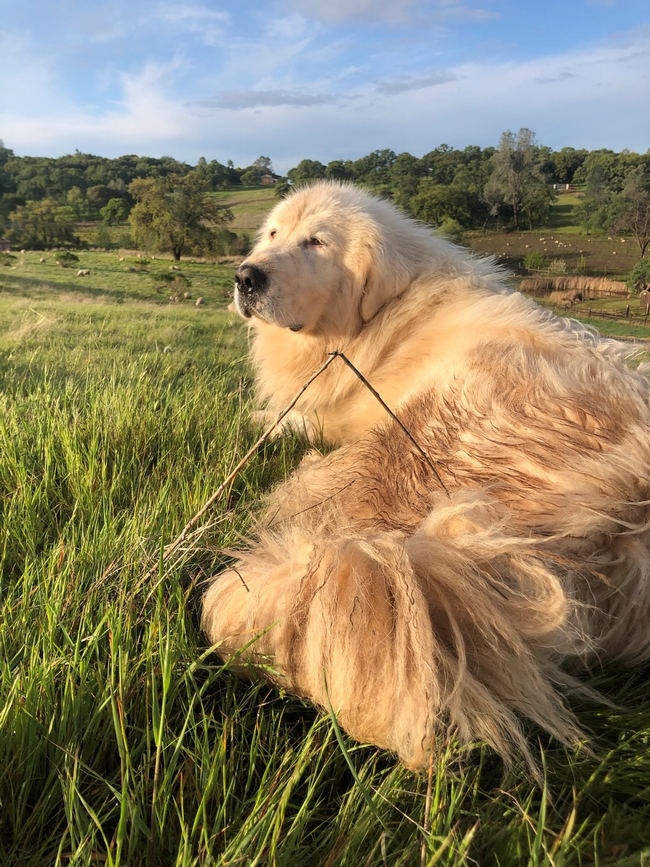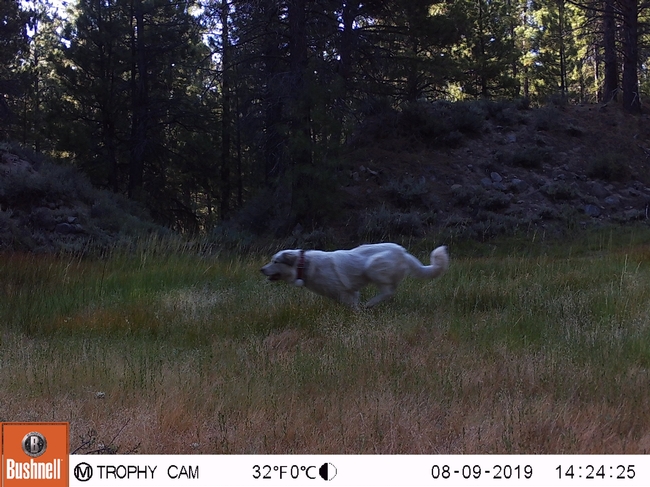- Author: Dan Macon
Last month, between dog food and vaccines, we spent just over $103 on our three livestock guardian dogs (LGDs). For the first part of April, our two older dogs (Bodie and Elko) were with our ewe-lamb pairs on annual rangeland west of Auburn. Our younger dog (Dillon) was protecting our rams. After we sheared the sheep over the third weekend of April, Dillon and Bodie went with the pairs to irrigated pasture; Elko stated with a handful of late lambing ewes at our home place. During that time frame, we lost a lamb to disease, another to a fencing mishap, and a third due to an assumed case of thievery (by Dillon - see "The Right Dog for the Job"). We didn't, however, lose any sheep to predators - in fact, we haven't lost any sheep where they were protected by dogs for at least half a decade. But how do we know whether our dogs are a cost-effective livestock protection tool?
Along with my colleague Carolyn Whitesell (UCCE Human-Wildlife Interactions Advisor in the Bay Area), I just published a new peer-reviewed analysis of the economics of LGDs in the Western Economics Forum (you can download the full paper here). If you're not into reading journal articles (and who is, really!?), here are our key findings:
Benefits of Using LGDs
- LGDs likely reduce the indirect, stress-induced losses associated with depredation (including reduced weight gains, lower conception rates, and increased labor).
- Ranch-raised ewes may have greater value than purchased ewes given their local adaptation to management and forage conditions.
- Sheep guarded by LGDs travel greater distances to forage in rangeland conditions, increasing grazing efficiency.
Cost Factors
- Labor costs and dog:livestock ratios vary greatly in real-world settings. Maximizing labor efficiency, and determining the proper number of dogs by operation and season can reduce costs.
- Successful bonding techniques are a key driver in LGD acquisition and development costs (and subsequent depreciation expenses).
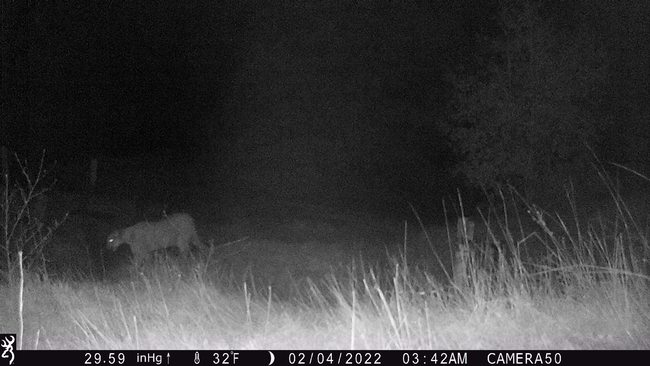
- Author: Dan Macon
When it comes to livestock protection tools, there are no "silver bullets"....
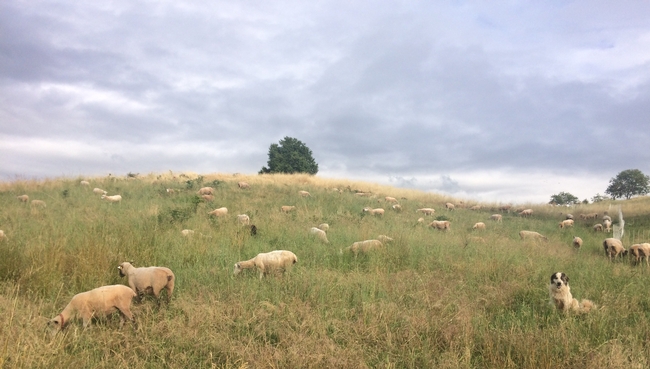
I want to start this blog post by saying I'm convinced that livestock guardian dogs (LGDs), if properly bred and bonded, are the most effective livestock protection tool available to me as a small-scale commercial sheep producer. I have game camera photos of coyotes, bobcats, foxes, and even mountain lions within 50 yards of our lambing paddocks that prove to me that our dogs are working. I have lost replacement ewes to coyotes in each of the last two years where we were unable to have a dog with our sheep. But like every nonlethal tool in my tool box, LGDs are not a silver bullet. They aren't perfect, and I was reminded of this today.
I've written frequently about our bonding process - about the importance of bonding a young pup with OUR livestock and our management system. Over the 17 years that we've raised sheep and used dogs, I've become better at managing this process. I select pups from working parents - pups that are born where they can hear and smell sheep before their eyes are open. I put pups with dry ewes as soon as I can (preferably at 8-10 weeks of age). I put teenage dogs with rams to cure their desire to play and roughhouse. And I put young dogs (at 18-24 months) with an older dog at lambing as part of their final exam - an older dog will often enforce respect for the lambing process and ensure that a younger dog doesn't interfere (or worse, steal or kill a lamb).
But every dog is different. Just as every border collie pup out of working parents doesn't necessarily make a sheep dog, every LGD pup doesn't make a trustworthy guardian.
I bought Dillon several years ago at an auction - he was a promising pup from a sheep outfit in northern Nevada. We bonded him as we bond all of our LGDs - and he made expected progress - for the most part. Dillon has been slow to mature behaviorally. Most dogs, at two-and-a-half years of age, are mature (mentally and physically). Dillon still acts like a pup sometimes. He's overly exuberant at feeding time. He bounds up to sheep playfully. He's a goofball.
And today, we think, he's a lamb thief.
For a variety of reasons, we have a small group of very late lambing yearling ewes this year - which is not our normal practice. Last week, we sorted off the ewes we thought were pregnant and kept them at home after we sheared the flock last weekend. Dillon, who had been with our rams, was turned out with the older pairs (and with an older dog) - we kept the pregnant ewes at home, with an older dog. Unfortunately, we missed one of the pregnant yearlings, and she remained with the main flock.
This morning, when my partner checked the main flock, he found Dillon with a newborn lamb in his mouth. Dead. The ewe was a maiden; an experienced ewe might have chased Dillon off. Unfortunately, this first-time mother did not - nor did the older dog. Now we're faced with a dilemma - we have a dog that's great with older pairs, dry ewes, or rams, but who wants to keep new lambs “safe” from their mothers.
Ultimately, I think, this comes down to selecting the right dog for the job - or maybe it's the right job for the dog. We currently have two outstanding lambing dogs - dogs who are entirely trustworthy with lambing ewes. We have a third dog, Dillon, who is effective in less complicated situations. How do we manage this going forward?
Every dog is different - just as every operation is different. Dillon is great with our rams. He's great with dry ewes or older pairs. He's not, unfortunately, a suitable replacement for our older lambing dogs. He's not a perfect dog - he's no silver bullet. The same can be said of any livestock protection too, ultimately.
- Author: Dan Macon
I suspect anyone who has used livestock guardian dogs (LGDs) to protect livestock has experienced at least one of the following interactions with non-ranchers:
- A call or conversation with a neighbor, complaining about the dog barking;
- An email (often anonymous) from a neighbor about the dog barking;
- A visit from animal control about (a) the dog barking, (b) the fact that the dog is outside ALL OF THE TIME, or (c) all of the above;
- A call from animal control that a well-meaning person "found" a stray big white dog and brought it into the animal shelter.
And the list probably goes on!
These complaints, in my experience, reflect a number of misconceptions. Most people think of dogs as pets, and expect that working LGDs should be treated as such (which apparently means letting them sleep inside). A surprising number of people here in the foothills have never seen any of our local predators (especially mountain lions) and so have no idea of the threat these predators pose to livestock. And virtually nobody who doesn't use a dog to protect livestock understands the types of behaviors that make for an effective LGD.
Nine summers ago, I received an anonymous email from a neighbor complaining about our LGD awakening him at 5 a.m. and suggesting that we use a bark collar on him. While my initial inclination was to respond immediately (and angrily), my wife urged me to sleep on my response (and, as usual, she was right about this!). Here's how I ultimately responded:
Sorry to hear that our dogs have inconvenienced you. As you may not know, we are in the commercial sheep business. All of our dogs are an essential part of our business - either as herding dogs or as livestock guardian dogs (LGDs). While most of our operation exists on leased land around Auburn, we do keep some sheep and goats at our home place. These are generally animals that require special care - orphaned lambs that must be bottle-fed 2-3 times daily, older sheep and goats that require special care and feeding, and an occasional injured or sick animal. Our property is zoned "Farm" by Placer County, which permits these commercial activities.
Sheep and goats are vulnerable to predators like coyotes, mountain lions and domestic dogs - even in a neighborhood like ours. Indeed, the only animals we've ever lost to predators were killed by a neighbor dog two years ago in our back pasture. At that time, we did not have any LGDs with the sheep. The neighbor dog was observed chasing sheep into the irrigation ditch and killing them for sport - we lost 4 ewes in the attack. Since that time, we've tried to make sure that we are always protecting our animals (and our livelihood). Our LGDs are critical to this effort.
LGDs instinctively respond to anything they perceive as a threat to the animals they are guarding. The best LGDs are raised with the animals they spend their lives guarding - our dogs have been with sheep from the moment they were whelped. Their first response to a perceived threat is to bark. If the threat persists, an LGD will aggressively challenge the threat. Sometimes the threat is readily apparent to us humans; other times it is not. We have experienced our dogs barking at the scent or sound of a coyote, which we only discovered later. We've also noticed that our LGDs can learn about routine - for example, they don't bark at folks who walk their dogs past our place at the same time everyday. Since barking is part of their guarding behavior, discouraging an LGD from barking will ruin the dog's effectiveness.
When we have LGDs at our home place, we are especially aware of their barking - both because it represents a potential threat to our livestock and because we want to be good neighbors. When a dog sounds a warning bark (and we've found that LGDs only bark when they are trying to warn off a perceived threat), we'll check it out - even in the middle of the night. Most of the time, our dogs relax and stop barking once we've responded to their warning barks.
I would like to invite you to visit our operation at some point. The partnership that we've developed over many years with both our herding dogs and our LGDs represents an amazing relationship between humans and dogs. We could not operate a commercial sheep business without this partnership, and watching our dogs work - even for us - is a wonderful experience. Also, we'd be glad to forward you additional information regarding LGD behavior and training.
Several days later, I received this response:
Thank you for your reply and detailed information regarding your business. We wish you the best success for your business! Someday my wife and I will come by and see your farm.
Thanks again for understanding and making great efforts in keeping the barking to a minimum as much as possible. We too have a dog, so we do understand.
While I still don't know who this neighbor was (and they still haven't visited our operation), we haven't had any further problems at our home place.

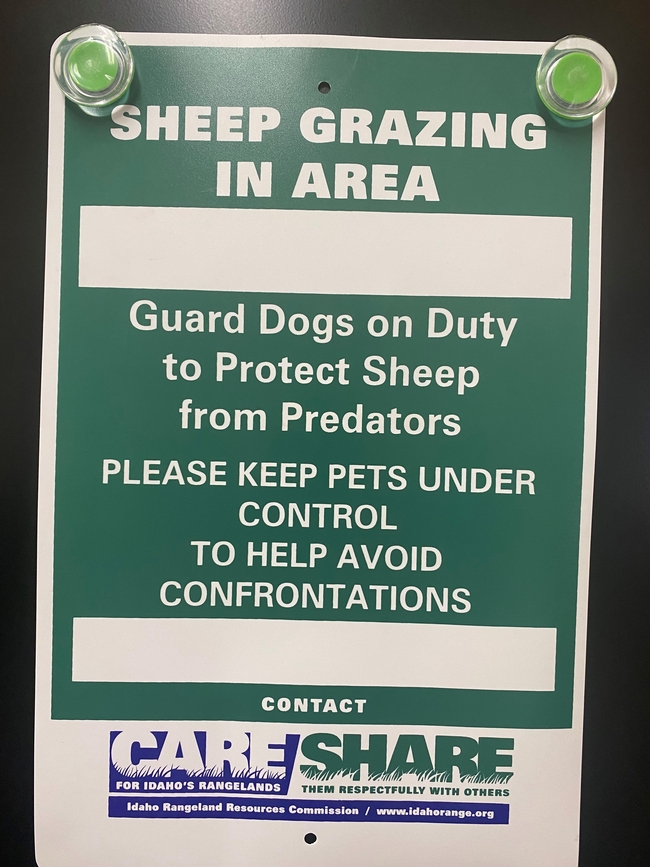
I'm often asked if there are particular LGD breeds that are less likely to bark. In my experience, barking varies more by individual than by breed - all LGD breeds are inclined to bark as a first line of protection. Our older dogs, typically, bark less - I suspect that experience often equals better judgment about what is a threat (and what isn't). When we're working in an area where neighbors are particularly sensitive to barking, we'll try to use an older dog if possible.
Finally, we've discovered that trail cameras can help us educate neighbors (and the public) about the predators in our environment. Last year, we photographed a mountain lion on a well-used community trail about 30 yards from where our ewes were lambing. Nobody in this neighborhood had seen a lion before; suddenly, they were happy to have an alert (and barking) dog nearby!
LGDs are not appropriate in every situation. While they may keep raccoons out of a suburban backyard chicken coop or away from pet pygmy goats, there are generally better options for protecting livestock in suburban settings. As a farm advisor, most of the calls I've received in the last 4-plus years have been about LGDs in these kinds of settings. Predator-proof fencing, night penning, and FoxLights are usually effective in these situations - and less annoying to the neighbors. But in a commercial setting, LGDs may be the best option for protecting livestock - explaining how and why these dogs work is an important part of using them effectively.
- Author: Dan Macon
When we started in the commercial sheep business over 15 years ago, we knew we wanted to use livestock guardian dogs (LGDs) to protect our sheep from predators. LGDs were not as common then in the foothills as they are today, so our choices were somewhat limited - and my knowledge of these dogs was even more limited. One LGD puppy looked much like another (white and fuzzy) - and while I knew enough to pick a pup from working stock, I didn't know the questions I should be asking - or even what I should be looking for in terms of behavior. While we were lucky enough to pick up an older dog who turned out to be a decent protector, our record of success in our early years was mixed at best.
As we gained more experience using LGDs, we started to look for specific traits in new dogs. And we started to realize the importance of appropriate bonding and early-life "training" (I use the word "training" here differently than I might use it with respect to a herding dog - training a LGD doesn't necessarily involve teach a dog specific commands). As I've gained more experience and insight, our record of success has improved.
Over the last six months, I've been collaborating with extension colleagues in California and elsewhere to increase our understanding about what makes a solid livestock guardian dog. Carolyn Whitesell, who is the new human-wildlife interactions advisor with UC Cooperative Extension in the Bay Area, has experience working with LGDs in Africa. Bill Costanzo, who comes from a California sheep background, is a LGD extension specialist with Texas A&M. We've worked to come up with a new fact sheet on selecting the right LGD puppy. You can download it here.
Over the coming months, we hope to produce a series of fact sheets on caring for your LGD, as well as on bonding techniques and problem-solving. Carolyn and I will also be surveying producers about their techniques for bonding LGDs with livestock. Stay tuned!
In the meantime, you may want to check out my Flying Mule Dogs channel on Instagram - you can follow me at @flyingmule. I'll be posting additional videos about the LGDs we use in our operation!
- Author: Dan Macon
When we first started using livestock guardian dogs nearly 15 years ago, I often joked that we our sheep operation was "predator-friendly" because our dogs were not. In other words, the protective behavior of our dogs allowed us to avoid using lethal control on coyotes, mountain lions, and other predators in our environment. And in those 15 years, knock on wood, we've never had to kill a predator. This isn't to say we wouldn't use lethal control if we came upon a predator killing our sheep, but our dogs (for the most part) seem to be doing their jobs.
California now has a predator (the gray wolf) that is protected under both the State and Federal Endangered Species Acts. Under both laws, it is illegal to "harm or harass" a wolf - and lethal control (at least in California) is not an option (even if a wolf is killing livestock). Consequently, the potential interaction between LGDs and wolves takes on new implications - could a rancher whose dog injured (or even killed) a gray wolf be held liable for "taking" an endangered species? Would the California Department of Fish and Wildlife, which recommends LGDs as a non-lethal livestock protection tool in wolf country, actually prosecute such a case?
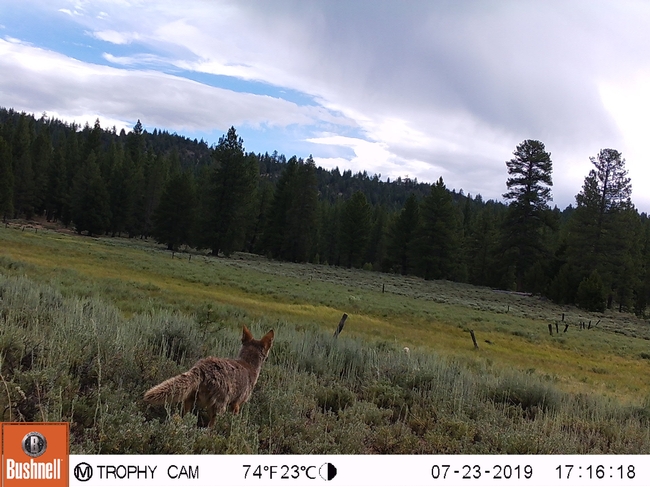
More than two-thirds of these dogs had no reported interactions with wildlife. Of the 71 dogs that did interact with wildlife, 48% interacted with herbivores, while 73% interacted with predators. Just 9% had lethal interactions with herbivores (where the herbivore was killed); 10% had lethal interactions with predators. All of the documented interactions between LGDs and predators (a total of 44 instances) were defensive in nature (in other words, the predator approached the herd and the dog responded). Ultimately, the authors conclude, "Overall, the conservation benefit of LGDs does not appear to be outweighed by ethical implications of their use; LGDs were shown to be highly targeted and discriminatory towards predators attempting to predate on livestock." In other words, the LGDs in this study were effective at deterring predation while minimizing impacts on non-threatening wildlife.
I found this research especially interesting in light of my own observations of our LGDs and the LGDs used by other California operations. I've never witnessed a direct interaction between our dogs and a predator (which is why we're using GPS collars and trail cameras to try to document these encounters). In my 15 years of using these dogs, I've encountered 2 dead raccoons and 2-3 dead jackrabbits in our sheep paddocks, which I assume were killed by our dogs. I have also observed two of our dogs going after an otter (which is a much more vicious predator than I'd realized). I know that our dogs will respond when they hear coyotes howling in the distance, but I've never seen a direct confrontation.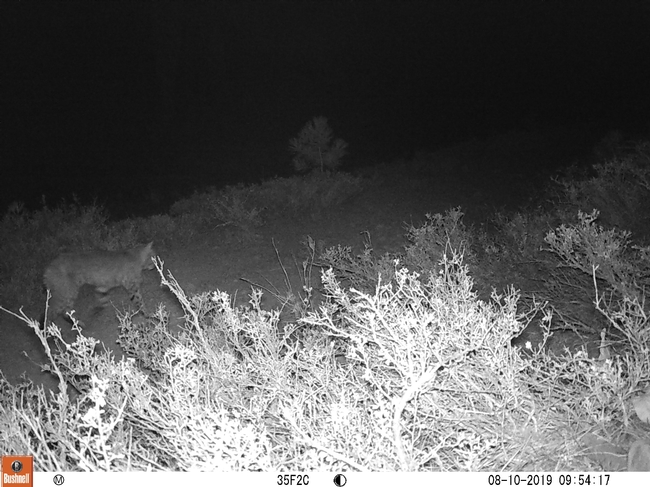
Working with several range sheep operations this summer, I suspect that wildlife encounters may be more common in these unfenced, herded systems. The herders I've worked with report that the dogs are very active at night (as some of my trail cameras and the GPS data suggest).
I'm interested in learning from other producers - how do your LGDs respond to non-threatening wildlife versus predators? What kinds of things do you do to correct inappropriate behaviors? I hope you'll share your insights in the comments to this blog!


